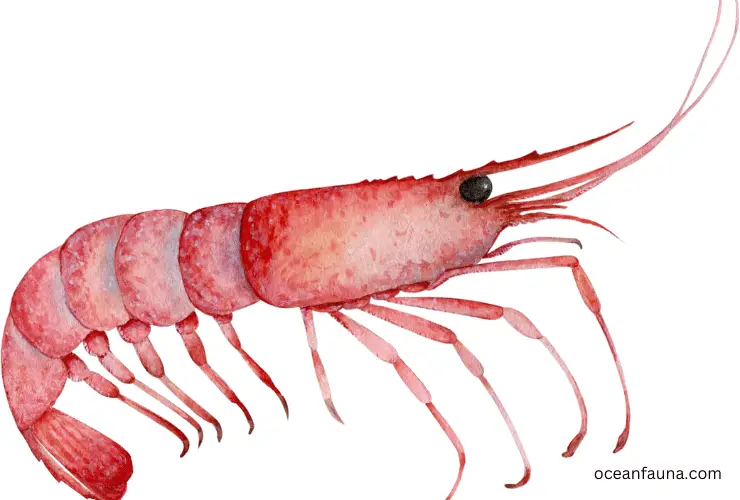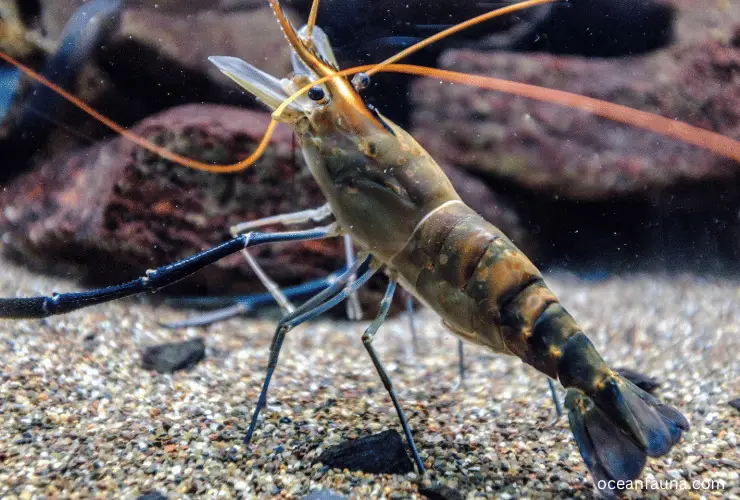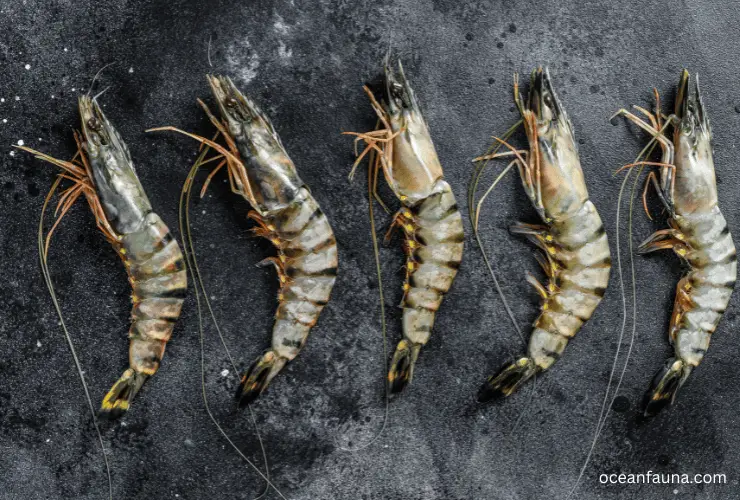No, shrimps are not categorized as bugs or insects. Instead, they are crustaceans that are related to lobsters and crabs.
To know more in detail about why shrimps are not bugs and what are similarities and dissimilarities they have read the article. Here I have provided some of the key points to understand why shrimps are not bugs:
Are Shrimp Bugs?
No, shrimps are not categorized as bugs. In fact, shrimps are crustaceans, which means they belong to a group of arthropods that also includes lobsters, crabs, and crayfish.
The bodies of shrimps, like other crustaceans, are made up of segments and are covered in a hard exoskeleton. They also have joint appendages that allow them to move about and easily catch their prey.
Additionally, like other crustaceans, shrimps have multiple pairs of antennae that they use for both sensing their environment and communicating with others of their species.
While shrimps may not be bugs, they are a popular seafood item that is enjoyed by many people all over the world. Shrimps are a good source of protein and are low in fat, making them a healthy addition to any diet. They can be cooked in various ways, such as boiled, grilled, or sautéed, and are often used in dishes like stir-fries, pasta, and salads.
Why Are Shrimps Not Bugs?

Shrimps are not bugs despite their similarities due to several distinct characteristics that set them apart. These differences include their anatomy, behavior, and habitat.
Anatomy
Shrimps and bugs belong to the group of animals known as arthropods, meaning they share a similar exoskeleton structure. However, shrimps are classified as crustaceans, a subphylum within the arthropod group.
Their bodies are elongated, with two pairs of antennae and ten walking legs. In contrast, bugs are insects with three pairs of legs, one pair of antennae, and usually two pairs of wings. Again, where shrimps have gills to breathe, bugs have breathing tubes known as spiracles.
Behavior
There is a significant difference in the behavior of shrimps and bugs. Shrimps are aquatic creatures that reside in both freshwater and saltwater environments. They live at the bottom of water bodies and feed on invertebrates, algae, and decaying organic matter.
Bugs, however, are land animals that have adapted to different environments using techniques like camouflage and flight.
Habitat
As mentioned earlier, shrimps and bugs live in distinct habitats. Shrimps are found in bodies of water, ranging from slow-moving streams to deep oceans. They are adapted to living in water and must spend their lifetime submerged in it.
Also Read: Are Shrimp Decomposers? [Answered]
In contrast, bugs are found in various environments, including forests, deserts, and grasslands. While some bugs, such as mosquitoes, breed in water, they can also live entirely outside of it.
Why Are Shrimps Compared to Bugs?
Shrimps and bugs share several physical characteristics and behaviors, which is why people often compare them. Both have segmented bodies and jointed legs and belong to the same arthropod family, placing them in the same taxonomic category.
Moreover, shrimps and bugs share several dietary habits. Both are opportunistic feeders and will eat almost any food they can find.

Additionally, both have an exoskeleton to protect their bodies from predators. As shrimps and bugs grow, their exoskeleton becomes too small for their increasing size, and they have to shed it periodically. This process is known as molting.
Another similarity between these creatures is that they are often seen scavenging for food. Bugs can be found eating crops, dead plants, and even other insects, while shrimps scavenge for dead animals or plants in the ocean.
Both creatures have adapted to their environments in a way that allows them to survive mainly on what they find rather than what they can hunt.
Are Shrimps Related to Cockroaches?
Despite popular belief that shrimps are the “cockroaches of the sea,” scientific evidence shows that they are not directly related to cockroaches. Both shrimp and cockroaches are indeed part of the same phylum, Arthropoda, but this does not make them close relatives.
In fact, shrimps and other crustaceans are more closely related to insects than to cockroaches alone. They belong to a subphylum called Pancrustacea, encompassing all crustaceans and insects.
While shrimps and cockroaches share some biological similarities, they have distinct differences in their anatomy, behavior, and habitat. For example, shrimps have an exoskeleton made of chitin, while cockroaches have an exoskeleton made of sclerotin. Shrimps are aquatic creatures, while cockroaches are terrestrial.
Moreover, shrimps have complex social behaviors and tend to live in groupings, while cockroaches are generally solitary and do not exhibit such behavior. These differences in their characteristics suggest that their genetic relationship is quite distant.
Similarities Between Shrimps and Cockroaches
Here are some of the key similarities between shrimps and cockroaches:
Exoskeletons
Both shrimps and cockroaches have exoskeletons – hard outer shell that provides protection and support for their bodies. In fact, they both belong to the same phylum – Arthropoda – which includes all animals with exoskeletons.

Segmented Bodies
Another similarity between shrimps and cockroaches is that they both have segmented bodies. This means their bodies are divided into sections, each serving a specific purpose. In both creatures, the segments are connected by joints, which allow for movement and flexibility.
Antennae
Shrimps and cockroaches also have antennae, sensory organs that detect their surroundings. While the antennae of shrimps and cockroaches may look different, they serve the same basic function.
Omnivorous Diets
Both creatures are omnivorous, meaning they eat both plants and animals. Shrimps and cockroaches are known to consume a wide variety of food, including algae, insects, and small fish.
Adaptability
Shrimps and cockroaches are both adaptable creatures, able to survive in a wide range of environments. Shrimps can be found in both freshwater and saltwater habitats, while cockroaches are known for thriving in urban environments.
Social Behavior
While not all shrimp species exhibit social behavior, some do form large groups known as schools. Similarly, certain species of cockroaches have been known to engage in social behavior, living in large groups and communicating with each other through pheromones.
Dissimilarities Between Shrimps and Cockroaches
Here are some dissimilarities between shrimps and cockroaches:
Body structure
Shrimps and cockroaches belong to different phyla and classes. Shrimps belong to the phylum Arthropoda and class Malacostraca, while cockroaches belong to the phylum Arthropoda and class Insecta.
The body structure of shrimps and cockroaches is significantly different. Shrimps have a hard exoskeleton that covers their entire body, while cockroaches have a soft exoskeleton that covers only their head and thorax.
Antennae
Shrimps possess two pairs of antennae, also known as whiskers. One of these pairs is significantly longer, reaching twice the length of the shrimp, while the other pair is relatively shorter. Shrimps utilize their antennae primarily for sensory functions.
In contrast, cockroaches possess only one pair of antennae, which are short and thick. Cockroaches use their antennae primarily for locomotion – they help them navigate in their environment.
Habitat
Shrimps and cockroaches also differ in their habitat. Shrimps are aquatic animals that live in freshwater, saltwater, and brackish water habitats. Cockroaches, conversely, are terrestrial insects living in warm and humid environments such as homes, restaurants, and garbage dumps.
Feeding
Shrimps and cockroaches also differ in their feeding habits. Shrimps are omnivorous and feed on algae, small fish, and aquatic plants. Cockroaches are primarily scavengers and feed on decaying matter, including animal waste and dead insects.
Reproduction
Shrimps and cockroaches reproduce differently. Shrimps reproduce sexually and lay eggs, which hatch into larvae and then develop into adult shrimps. Conversely, cockroaches reproduce sexually and lay eggs that hatch into nymphs and then develop into adult cockroaches.
Physical appearance
Shrimps and cockroaches also differ in their physical appearance. Shrimps have a streamlined body that is divided into two parts, the head, and the thorax, and they have five pairs of legs. Cockroaches have a flattened body divided into three parts, the head, thorax, and abdomen, and six legs.
Conclusion
Now you know that shrimps are not the same as bugs and are not closely related to cockroaches. While they share some physical traits and both belong to the arthropod phylum, there are notable differences between them.
Shrimps can be cooked and eaten safely, while bugs be consumed cautiously as they could be toxic.
In addition to that, shrimps have gills that enable them to breathe underwater, while bugs rely on breathing tubes for breathing. Considering all the differences, I would say shrimps are not bugs.

